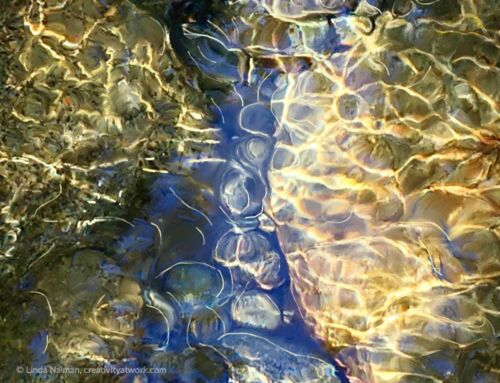One thing I know for sure is that my creative practice keeps me grounded and connected to my innermost self, and the larger world.
I subscribe to Joni Mitchell’s creative practice, which she shares in her inspirational documentary Woman Of Heart And Mind: A Life Story (2003):
 I’m a painter first and a musician second, as it turns out. Any time I make a record, it’s followed by a painting period. It’s good crop rotation. I keep the creative juices going by switching from one to the other, so that when the music or the writing dries up, I paint. You rest the ear a while and you rest the inner mind, because poetry takes a lot of plumbing the depths. I mean, the way I write, anyway, it takes a lot of meditation. Without the painting to clear the head, I don’t think I could do it.
I’m a painter first and a musician second, as it turns out. Any time I make a record, it’s followed by a painting period. It’s good crop rotation. I keep the creative juices going by switching from one to the other, so that when the music or the writing dries up, I paint. You rest the ear a while and you rest the inner mind, because poetry takes a lot of plumbing the depths. I mean, the way I write, anyway, it takes a lot of meditation. Without the painting to clear the head, I don’t think I could do it.
What does my practice involve? Reflection and contemplation via meditation and journaling to incubate ideas and surface insights; time in the forest or at the seashore to recalibrate; reading and learning from different disciplines; and experimenting with new ideas. All of these practices feed my creativity in writing, art-making, design, and business.
If you are looking for more depth and breadth in your own creative practice, you will find inspiration in these two books:
Deep Creativity: Seven Ways to Spark Your Creative Spirit, by Deborah Anne Quibell, Jennifer Leigh Selig, and Dennis Patrick Slattery, PhD; and Be Wise Now: A Guide to Conscious Living, by Gael McCool.
Deep Creativity: Seven Ways to Spark Your Creative Spirit
By Deborah Anne Quibell et al
Deep Creativity is an invitation to intentionally and introspectively engage with the creative life through seven time-tested pathways: The Way of Love, The Way of Nature, The Way of the Muse, The Way of Suffering, The Way of Practice, The Way of the Sacred, and The Way of Art. The authors show how the 7 Ways have informed their own creative process and provide reflective and practical exercises on each.
I am particularly fond of the chapter on The Way of Art and The Ekphrastic Response by Jennifer Leigh Selig. I had not heard of this word before, so my curiosity was peaked. Selig cites James A. W. Heffernan’s essay called “Ekphrasis and Representation,” in which he defines ekphrasis as the “verbal representation of graphic representation.” More simply defined, words inspired by images.
For example, William Carlos Williams’s 1962 poem “Hunters in the Snow,” is a response to Pieter Bruegel’s 1565 painting Return of the Hunters. Williams’s poem is a literal representation of the image on the canvas, a translation of sorts, from one medium to another.
Selig points out the literal definition of ekphrastic art—“making words from images”—is a whole-brain response. That is, the right brain is typically seen as our image processor, and our left brain, our word processor. So when we view ekphrastic art, those images side by side with those words, we are having, at least symbolically, a whole-brain experience.
If your creative output more is skewed more toward words or more toward images, you can cultivate your ekphrastic by creating visual images from poems or stories, and vice-versa.
Selig describes the call and response of art as being akin to breathing.
First, we breathe in. Inhalation is analogous to experiencing art. We go to a museum and breathe in the work of the masters old and new. We attend a rock concert and breathe in the raw energy of the band on the stage. We sit down with our favorite author and breathe in the delightful entanglement of words on the page. Breathing in is the movement of taking art into us, art which is breathtaking to us.
But there’s a second, necessary movement, and that’s breathing out. We breathe in the art of others, let it mix with our particular chemistry, our unique spirit, and we breathe out in response. Exhalation is an ekphrastic response. It is a form of creative homage—a mirroring, an extension, a parallel, a response to the art we have taken in.
This exhalation as an ekphrastic response, is what I believe Picasso meant when he said great artists steal.
I have read many books on creativity over the years and I find this book to be both refreshing and inspiring. It speaks to me as a creative, it challenges me with questions for reflection and it offers a pathway for me to add more depth and breadth to my practice. You can buy Deep Creativity on Amazon
Be Wise Now: A Guide to Conscious Living
By Gael McCool
“Every life is a sacred work of art—an assemblage of real and surreal, fact and fiction, order and chaos—a divine mix of mess and magic,” says author Gael McCool. “What holds it all together is your capacity to create stories, extract meaning from your experience, and assemble the pieces into an evolving narrative about who you are and your place in the world.”
Be Wise Now is an invitation to engage compassionately in the deeper story of your many selves. There are 15 in all, including the deeper story of the soul, the embodied self, the survival self, the imaginative self, the shadow self, and ultimately the deeper story of your integrated self.
These stories describe the particular qualities of the self when in alignment, key areas for development drawn from a diversity of sources including science, psychology, and spirituality, and dominant questions for reflection. The arc of development takes us from unconscious existence to awakened authenticity.
McCool describes the deeper story of your integrated self as one of:
Learning about, listening to, understanding, and accepting all aspects of yourself is what makes integration possible. Integration optimizes your strengths and recognizes genuine limitations. From an integrated state, you have the potential to have a profound effect on others—simply by being yourself.
Integration is experienced as a state of deep presence, having a sense of interconnectedness, living in the moment while also holding mindfulness about your impact and its ripple effect, maintaining awareness and acceptance of your limitations, operating from a mature consciousness, devoting time and energy to a calling beyond personal benefit, accepting others, and having a sense of humor and perspective.
I get a strong sense from reading McCool’s book that her wisdom is hard-one, and that makes her writing all the more precious. Her book is a balm for the soul. Be Wise Now is available on Amazon
As an aside, I met McCool on several occasions years ago when she contributed to Orchestrating Collaboration at Work and was embarking on an intense spiritual quest. I admired her courage and dedication.
You may also like:






